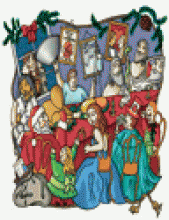Background
Although the study of children's literature as it applies to medicine has traditionally been the province of the psychoanalytic field,1 authors in other disciplines such as pediatrics have also devoted attention to the subject.2 To our knowledge, however, the extent to which medical authors have drawn on the story of Cinderella has gone unrecognized. A review of the literature reveals a tradition that draws upon the familiar children's story of a young woman and her wicked stepsisters and conceptualizes neglected medical and scientific trends as “Cinderellas.” We propose that the study of this phenomenon be called cinderology. In this article we examine the widespread use of Cinderella as a medical metaphor and offer an explanation for its popularity.
Methods
A search of MEDLINE was performed on Aug. 7, 2004 using the search term “Cinderella.” The search was limited to the years 1999–2004.
Results
The initial search yielded 52 articles. Of these, 9 were eliminated because they did not feature the search term in the title and we were not inspired to read the articles in their entirety. An additional 2 articles were excluded because they appeared to be referring to a specific dermatitis rather than using the term “Cinderella” in a metaphoric sense. Of the remaining 41 articles, we looked at the titles only. Eleven of these3,4,5,6,7,8,9,10,11,12,13 identified a specific disorder as the “Cinderella” of its field (e.g., fibromyalgia as the “Cinderella of rheumatism”). One disorder, chronic obstructive pulmonary disease, was described as not a Cinderella.14 Seven titles15,16,17,18,19,20,21 made reference to an area of basic research (e.g., endothelial nitric oxide synthase as the “Cinderella of inflammation”16). Five procedures22,23,24,25,26 were called “Cinderellas” (e.g., nuclear nephrourology as the “Cinderella of nuclear medicine”). One specialty, family medicine, was referred to as a “Cinderella.”27
A secondary analysis revealed that 4 article titles alluded to Cinderella's attendance at a ball;20,28,29,30 this included a reference to adipose tissue, “ ‘the anatomists’ Cinderella' who ‘goes to the ball and meets some influential partners.’ ”20 Cinderella's sisters were mentioned in 3 titles.18,31,32 Her slippers were mentioned in 3 titles.33,34,35
Figure. Photo by: Earthlore
Articles originated from a number of countries including England, Finland, Germany, Ireland, Saudi Arabia, Spain and the United States. Only 2 were clearly from the field of mental health.30,36
Interpretation
What is it about the story of Cinderella that holds such appeal? The tale of a neglected young woman who later receives widespread recognition and admiration seems to resonate with authors from many areas of medicine. The identification of a particular disease or mechanism as a Cinderella may reflect the author's protective affection for his or her area of study: lonely researchers slaving away at their bench, studying an obscure medical phenomenon of interest to no one but themselves, may well imagine the day when 15-hydroxyprostaglandin dehydrogenase will take its rightful place as the belle of the medicine ball.17
It is also possible that authors themselves identify with the ignored and neglected character of Cinderella. Researchers, like proud parents, often do not realize that not everyone at the cocktail party wants to hear about congestive heart failure due to systolic dysfunction, or about the mammary myoepithelial cell. They begin to fantasize about being invited to present at an important conference where they might meet a handsome prince (or princess) — the head of a large national research granting body with a particular interest in myosin light chain phosphatase.
It may be suggested that our analysis of this phenomenon is limited by the fact that we looked at titles only and did not bother to read the articles themselves. We can hardly be faulted for this: very few people would be interested in reading an article about the patella component of total knee arthroplasty, least of all a couple of psychiatrists. Indeed, as psychiatrists, we suspect that the inclusion of the word “Cinderella” in these titles was a coping mechanism intended to obfuscate the excrutiatingly boring nature of the author's life work.
Conclusion
Based on its ubiquitous appearance in medical article titles, it is clear that the familiar story of Cinderella has had a profound influence on the way that authors conceptualize a wide variety of medical phenomena. The significance of this is only beginning to be understood. We anticipate the day when the heretofore understudied and underfunded discipline of cinderology will take its rightful place as a legitimate area of study for academics and clinicians.












